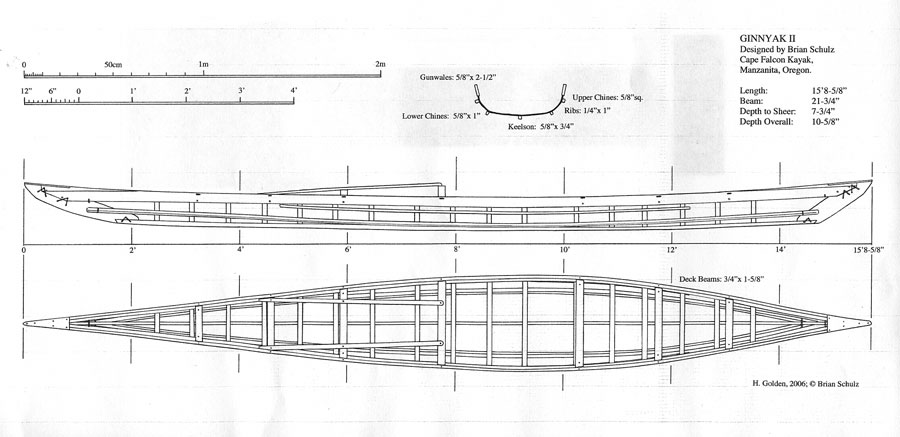Ginnyak II

NOTE: Ginnyak is out of production this year while I explore other design concepts, I have a redesign in my head right now for this kayak but I won't get to building it for at least six months. So the drawings below are outdated, and I won't be selling plans. The joy and curse of my work is that the boats are always evolving. This kayak remains true to it's design mission and I will be reintroducing it, but not for a while.
These drawings show the shape and framework of my own kayak design, evolved through dozens of incarnations. Ginnyak is a swift and manuverable low volume sea kayak. The shape is a no frills, no comprimises, approach to a specific set of challenges: maintaining control in large surf and heavy wind chop that I experience on my doorstep, the Pacific Ocean. The dramatically swedeform hull and low wetted surface area are the key to easy gliding. The conventional beam and secondary half-chine provide excellent stability on edge, allowing for better sweep turning. Low volume makes rolling easier and keeps you out of the wind. The kayak is normally fitted with sliding footbraces and a backrest. While it is a respectable flat water kayak, the Ginnyak is all about surf. Big waves, small waves, windchop, ship wakes. The Ginnyak wants to surf, and unlike most sea kayaks will straighten it's course on all but the steepest waves. You can pick up miles of mini surfs in a following sea. This same feature makes it want to slap and skitter heading into a chop. Pesonally I've always felt that paddling into a strong wind is futile and punishing, but when circumstances dictate I simply shove a bit of weight up front to calm down the bow. Still, for alot of windward work a greenland boat is undoubtedly superior. Not to mention that the Ginnyak can't compete for a moment with the unbridled sexiness of some Greenland replicas.
The splayed front deck stringers allow the installation of an 8" hatch between them. The lack of back deck stringers allow for more storage aft and for a deck load to sink as low as possible. The deck rigging is simple and functional latigo leather strapping, strong enough to accept a tow.
Hi Brian,
I just finished a Ginnyak that we build from your drawings and pictures. Paddles great and it is a lot lower volume than anything I have been in before. I was able to balance brace it with a paddle in one hand (something I had only read about till now). I am looking forward to learning a bunch of rolls, now that we have float bags in it. It came out surprisingly close to you specs. Thanks for a great design.
DJ Knott


Construction Notes:
You may copy and enlarge these drawings for your own use, or order a set of 24" x 32" drawings for whatever it costs me to print and mail them. Ginnyak is a building system as much as it is a shape. The drawings only tell a small part of the story. Of course not everyone can take a class and if you're handy you might be able to build one with little guidance. Some helpful dimentions:
The widest point of the boat should be no further forward than 5" in front of the backrest.
The ribs should be oak, locust, or ash, 1/4" x 1-1/4"
To set the rocker: when pressing the boat down at the cockpit, there should be one thumb width of rocker in the stern, two to four fingers in the bow.
On the water the bow may wag a bit from side to side, if this occurs, build up a stern rub strip, 1/4" at a time until there is only a bit of side to side motion with each stroke.
Sizing:
300 lbs 26" x 16 1/2'
250 lbs 24.5" x 16'
200 lbs 22.5" x 16'
175 lbs 21.5" x 15.75'
150 lbs 21 x 15.5'
125 lbs 21 x 15'
100 lbs 20.5 x 14.5'
back to Cape Falcon Kayak